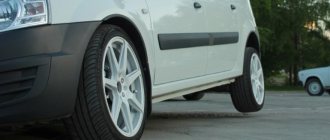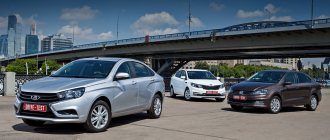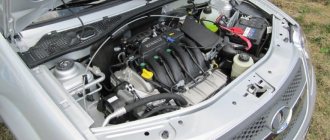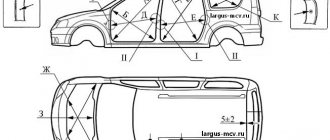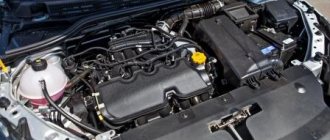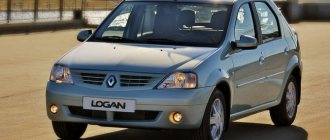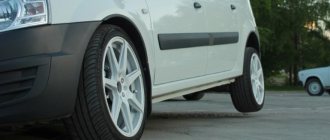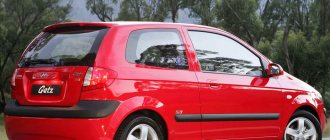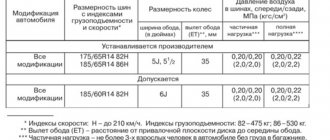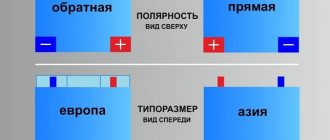It is no secret that the LADA Largus model, which rolled off the factory assembly line back in 2011, is a modified station wagon of French origin, the Renault Logan MCV. And this is no coincidence, because the “French”, thanks to its outstanding consumer qualities, has deservedly gained popularity not only in Europe, but also in Russia.
Here the buyer has the expected question: has the Largus model become better than its famous ancestor? Next, we will try to understand this aspect using specific examples. Let's try to find out which of the presented cars is better: Renault Logan or Lada Largus. To do this, let's make a comparison.
Renault Logan 2 or Lada Largus choice
Many people ask to share their impressions of Largus and compare them with Logan.
Well, in fact, Largus is a Dacia Logan MCV, i.e. There are not many differences with my Logan and some of them are: novelty, body type and equipment. Here are all the main differences =) I drove all modifications of Logan, from my 1.4 to my friend’s 1.6 16V.
Let's start the comparison with “Novelty”.
It is rightly said that a good car is a new car, this is true.
Largus is very interesting to drive, I was a little confused that the gas pedal is very sensitive, and the brake pedal is not as crazy as on Logans - this is definitely a plus.
The steering is very informative and soft, there are no differences from Logan. The engine is pleasantly responsive, it’s very pleasant to drive, it accelerates briskly.
I was also pleased with the gearbox, it is the same as on the Logans - smooth and soft, the gears shift clearly and it feels like the lever stroke is a little shortened compared to the Logans. It also seemed to me that first gear has become longer, you can not only start in it, but also accelerate.
The Largus's suspension is moderately stiff, it absorbs potholes like "Hurrah!", the car corners perfectly, better than my Logan =)
It seems to me that all my comments are a sign of novelty, and not technical improvements by Russian engineers.
I have a traditional Logan sedan, well, few others drive in Russia. Well, what can you compare here? Largus is huge compared to my Logan =) 7 seats and one lie-down in the trunk =) The station wagon, I thought, would be more clumsy than the sedan, but I didn’t notice a big difference.
My Logan 1.4 is the first generation, it has a basic configuration, i.e. there is nothing in it. Largus 1.6 16V has a luxury package and a similar interior to the second generation Logan, however, the plastic elements of the interior seem to be made in Russia. There is no point in describing what Largus is rich in - it is on the main page of the blog.
Let me summarize: Largus and Logan are similar in many ways, but there are also small pleasant differences. Largus is undoubtedly better than my Logan in all respects! True, in most respects it is similar to any second-generation Logan. Largus is good - this is what I, my dad and many Largus owners say, but Largus is the same Logan =)
Despite the fact that the manufacturer positions the Lada Largus as a completely new and independent model, at its core it represents a slightly modified Renault Logan MCV station wagon, which was popular in many countries around the world, including Russia. Whether such borrowing is bad or good is up to everyone to decide for themselves - some will not like copying other people’s ideas, even if officially permitted, while others will rejoice at the use of time-tested technologies. Considering that the Renault station wagon can still be bought in Russia, it will be interesting to know which is better - Logan or Largus? It is worth remembering that the car produced by VAZ underwent modifications before being put on the production line - many motorists want to find out what it was.
And again we compare the Lada Largus
Let's sum it up
Renault Logan MCV. This is a fairly comfortable station wagon that is perfect for urban everyday use. The car will delight you with a spacious trunk, high-quality interior panels and a large list of comfort and safety options. A good advantage of the “French” is the presence of a diesel power plant.
Disadvantages include weak adaptation to Russian climatic factors and higher maintenance costs. 2. LADA Largus.
If we compare, this is a model that is more successfully adapted to harsh operating conditions. The body has better protection against corrosion and chemically active environments.
Among the disadvantages are the poor interior equipment and the poor quality of the trim panels.
Concluding the review, choosing which is better from the presented Renault Logan or Lada Largus cars, let’s say that the question of choosing the optimal option from the presented two related station wagons is of a purely individual nature. Every practical owner will like one or another option, since both models have plenty of them.
Despite the fact that the manufacturer positions the Lada Largus as a completely new and independent model, at its core it represents a slightly modified Renault Logan MCV station wagon, which was popular in many countries around the world, including Russia. Whether such borrowing is bad or good is up to everyone to decide for themselves - some will not like copying other people’s ideas, even if officially permitted, while others will rejoice at the use of time-tested technologies.
Currently reading: Renault Logan gearbox: device and switching diagram | New Logan
And again we compare the Lada Largus.
Car appearance
It would be more correct to start the comparison with a station wagon from Russia, because this particular car is positioned as an alternative to the “French”.
Exterior and characteristics of Lada Largus and Renault Logan
Initially, the Russian car was modified to take into account the harsh conditions of our winters. In addition, the manufacturer applied special treatment to prevent corrosion of individual elements. The anti-corrosion layer is mainly used on the underbody and wheel arches. The thickness of the coating is approximately 5 mm thicker in comparison with Logan. The anticorrosive layer contains components that increase resistance to sudden temperature changes and the negative effects of various chemical reagents used to treat road surfaces.
Many note a more attractive exterior in comparison with Renault Logan. The paintwork on both cars is of high quality, the paint is resistant to chips, abrasions, etc. The overall dimensions of both of them - the Renault Logan or the Lada Largus - are approximately the same. The French station wagon has a length of 4492 mm, while the Lada Largus has 4470 mm. The width, height and wheelbase of the cars are virtually identical.
Largus has the advantage of protective linings on the arches. Moreover, these elements can be installed even in the basic configuration. Renault Logan does not have this. Largus is protected from gravel and small dust particles by rear pads. Additionally, there is an anti-gravel coating over a large area. The Frenchman cannot boast of this. Renault does not have a rear windshield wiper; Largus already has this useful accessory.
In general, the cars are similar in terms of trunk volume and other parameters, but if we consider the appearance, the domestic station wagon still looks more attractive.
Lada Largus Cross or Renault Duster
What's better? They differ from each other much more than in the case of Logan. Largus is a real station wagon, and Renault Duster in its all-wheel drive version was created as an off-road conqueror. The front-wheel drive version also shows good results on poor road surfaces thanks to its high ground clearance. Many may reasonably note that the Duster cannot be called a full-fledged SUV, but the versatile Largus can also cope with minor off-road conditions thanks to its increased ground clearance. But we are talking about comparing the basic capabilities of cars in everyday use, and not about the potential in exceptional cases.
Exterior of compared cars
Some experts are inclined to believe that the body of the Largus is more attractive than that of the Logan. The quality of the coating on both station wagons is excellent, regardless of the model of Renault Logan or Lada Largus. The paint firmly resists road “surprises”.
The dimensions of today's “heroes” Renault Logan or LADA Largus of the comparative test are very similar. In length, Lagrus, with its indicator of 4470 mm, is slightly inferior to the “Frenchman”, whose parameter is 4492 mm.
The advantage of the Lada is the presence of more durable linings around the perimeter of the wheel arches. These protective components are available for all trim levels of the Russian car, which cannot be said about Logan.
In addition, rear linings play their role in Largus, protecting the body from “bombardment” of stones and gravel. The anti-gravel coating here is applied over a larger area, which the French rival cannot boast of.
Renault also does not have a rear windshield wiper, but the domestic station wagon has this convenient and functional element.
The Largus washer fluid reservoir is larger in volume, so the owner is less likely to look under the hood to replenish it. However, this is not an indication that Renault Logan or LADA Largus is actually better.
Compare Lifan x60 and Renault Duster
Renault Duster alarm connection points
Interior
The French station wagon wins in terms of interior appearance: richer equipment, better quality materials, as well as a multimedia system with a large monitor. The highlight of the Renault Logan MCV is the basic offer, which can be installed for an additional fee:
- side airbags;
- alloy wheels;
- multimedia navigation system.
It should be noted that there is good visibility from the inside, thanks to the voluminous side mirrors. Regarding the dimensions of the luggage compartment, the Frenchman is also in the lead here: 573 liters versus 560 liters for the Russian. In turn, the Lada Largus boasts a more comfortable interior, as well as more space in the rear seats, which will significantly affect the comfort of passengers, especially on long trips. The Lada package also includes alloy wheels, ABS, front airbag and climate control for an extra charge.
What problems might you encounter?
The Largus suspension can hardly be called comfortable, but it is reliable. In seven-seater versions and vans, ball joints quickly fail due to the high load on the rear axle. The cost of a new spare part is from 1,000 rubles. Shock absorbers last up to 100 thousand km, but wheel bearings and CV joint boots last no more than 30 thousand km. Original brake pads last up to 40 thousand km, brake discs - up to 50 thousand km, so we recommend changing them at the same time.
Electronics are another weak point of the Lada Largus. When the contacts oxidize, the instrument panel malfunctions and displays unreliable information. And when several diodes in the generator bridge burn out, the battery stops charging altogether.
Rust is a friend of the LADA Largus, which goes hand in hand with it almost from the factory. First of all, doorways and sills are affected, then the engine compartment, hood and bumper. The reason for rapid corrosion is the poor quality of the paintwork.
What engines are on the Lada Largus?
The Largus is equipped with a 1.6-liter engine, which, on the one hand, has established itself as a relatively reliable unit. On the other hand, due to the maximum economy with which it was created, it requires a lot of attention and maintenance. The motors are not quiet and smooth and, despite the same volume, operate differently. We'll tell you which Largus engine is better.
Until 2012, Largus were equipped with engines from Logan: 1.6 liters with a power of 84 or 102 hp. With. With timely replacement of spark plugs, oil with filters and timing belt, French engines run up to 150 thousand km. The belt lasts up to 120 thousand km, and replacing it costs about 4 thousand rubles.
Modern Largus are equipped with Russian 8- or 16-valve engines with a volume of 1.6 liters and a power of 87 or 106 horses. In these engines, special attention should be paid to the condition of the timing belt, which lasts up to 60 thousand km. If it breaks, the valve will bend. In addition, the hydraulic compensators that regulate the valves are not provided in the engine, so this will have to be done at a service center at least every 30 thousand km.
Also, Russian engines have problems with throttle valve failure and frequent failure of certain sensors. In terms of noise and vibration levels, domestic engines are also inferior to French ones.
With foreign engines, French gearboxes were installed in Largus. A five-speed manual transmission lasts up to 200 thousand km, and the clutch lasts about as long as the gearbox itself. A new one will cost 4.5 thousand rubles, and the cost of the box itself starts from 70 thousand rubles. Automatic transmission has never been installed on Largus.
Vehicle Specifications
In this regard, all the cars turned out to be different from each other, so there is something to compare here.
Review of Largus and Duster
The power plants of the two cars have the same volume, but there are differences between them. Both cars are budget, so the volume of 1.6 liters (with a slight difference of a few cubic centimeters) is standard. Duster wins due to its greater power; it has a maximum of 114 horsepower. These horses are clearly not enough for a full-fledged SUV, especially considering that the latter have a power of 300 hp. With. and higher is a common indicator, and engine volumes are much larger.
The Lada Largusa has an engine power of only 87 hp. s., but on the road the difference of 30 horses is practically not felt, given the different weights of the cars, and the acceleration is approximately the same. The torque of Duster is 156 N/m, and that of Largus is 140 N/m. From this we can conclude that the engines have many similarities, but Duster’s power unit is still adapted for off-road driving. Even taking into account the Largus Cross version with increased ground clearance, it should not be regarded as an off-road conqueror.
The transmission of two cars is manual, five-speed. However, Duster has clearer manual transmission shifts. In addition, the “French” boasts a full-fledged 5-band automatic transmission.
Logan or Largus
Both have front-wheel drive with MacPherson strut suspension. Logan has a gasoline engine with a capacity of 73 horses. And the station wagon version additionally has an 84-liter diesel engine. With. The Lada does not have a diesel engine and is not expected to have one, but it has two gasoline engines. In addition to the above, there is also a more powerful 102 hp power unit. With.
All cars can use both 92 and 95 gasoline. Actual fuel consumption is approximately the same, except that the Duster is voracious in the city.
Is Largus a copy of Logan?
Experts note that the Lada Largus is an almost complete clone of the Renault Logan. True, there are some nuances in cars that distinguish them. More on this below.
Exterior
Rear seats (Renault Logan edition)
If you examine Logan from the outside, you may not notice the details in which it differs from Largus. Externally, the cars are almost identical. But inside the cabin, changes are immediately noticeable. All of them are in favor of Lada.
Salon Lada Largus
The driver can sit comfortably behind the wheel in one or another car. The seats can be adjusted in different positions.
The disadvantages of Renault include some small details, for example, the heater control is located too low. (Renault Logan editors)
To adjust, you will need to take your eyes off the road. Also, with the rear row seats folded down, the car becomes too noisy.
Otherwise there are no differences. The handling of the car is the same, the landing too. The build quality is good, as are the ergonomics. The only difference between the cars is the cost.
Service
It should be noted that most Renault owners “get” some little things. For example, the backlighting of the buttons often burns out. When contacting a service station, it turns out that the entire button must be replaced, since the diode cannot be replaced separately.
In winter there are no problems with both cars. They start the first time. Here you just need to monitor the quality of the fuel. The suspension is good; unscheduled replacements of its elements will not be required during normal operation.
Specifications
Both cars can be equipped with a range of engines, which include both diesel and petrol units. They can work in tandem with mechanics or automation. Drive – front. The engine power in both cars is enough for comfortable movement on the highway and in the city. The cost of spare parts will be cheaper for Lada, which is its advantage over Renault.
Results
Which car to choose is up to you. Here you need to take into account your capabilities and the conditions in which you plan to operate the car.
Interior of Lada Largus and Renault Logan
Regarding the external appearance of the cabin space, you can notice that in the interior Logan looks more attractive than its Russian competitor. The “European” materials are of higher quality and more pleasant to tactile manipulation. The level of equipment with comfort options is higher, which is confirmed by the multimedia complex with a large display.
The basic configuration of the “French” can be supplemented with the following options for an additional fee:
- side pillows;
- light alloy wheels;
- navigation system.
Side mirrors allow drivers of both station wagons to have good visibility.
Next up is luggage compartments. Logan’s capacity turned out to be better, because 573 liters of usable space left behind the competition of 560 liters that the Russian model can offer. Almost the same volume, so it’s difficult to choose which is better: Renault Logan or Lada Largus.
Largus “wins back” thanks to a more spacious interior. There is more room for the legs of passengers in the stern, so on long trips they are certainly endowed with sufficient comfort.
The Lagrus package also provides the possibility of installing alloy wheels, an ABS system, a driver airbag and an air conditioning system. Naturally, all this is available for some additional payment. We continue the comparison in an attempt to determine which is better than Renault Logan or Lada Largus.
Differences between domestic and French models
Let's start with the Russian station wagon. Note that the designated car was initially conceived and designed taking into account the severity of the domestic climate. Separately, we note the level of anti-corrosion treatment of body elements. The protective layer on the bottom and in the Largus arches is 5 mm thicker compared to the protection in Logan. The treatment composition includes substances that exhibit increased resistance to temperature fluctuations and the effects of aggressive road reagents.
If we compare, the interior ventilation system in Lada is more efficient, which allows you to heat the interior faster in cold weather. In general, the heating system on both station wagons is quite reliable and does not bother owners with malfunctions. Sometimes you can hear complaints about insufficient fan performance from owners of 7-seater versions of Logan MCV. The situation changes dramatically in favor of the “French” in the summer. Its climate control turned out to be more effective than similar equipment in Largus. We continue the comparison, choosing between Renault Logan or Lada Largus.
Main Differences
If we start with the Russian station wagon, it should be noted that the car was originally designed for the harsh climate of the country. The anti-corrosion treatment of the body on Largus, which is 5 mm thicker in contrast to its French counterpart, deserves special attention. It includes components that are more resistant to temperature changes, as well as protected from the effects of aggressive chemicals. The Lada also has more efficient airflow, which has a positive effect on the climate inside the cabin, especially in the cold season. The Renault plant installs a reliable electric heating system on the MCV model, however, in the Russian cold it is not always enough, especially in the 7-seater version of the Frenchman.
Nissan Almera
Nissan Almera produced by the Tolyatti Automobile Plant is a significantly redesigned “Japanese” Nissan Blubird Sylphy of the 2005 model year, built on the same B0 platform as Logan.
Nissan Almera produced by the Tolyatti Automobile Plant is a significantly redesigned “Japanese” Nissan Blubird Sylphy of the 2005 model year, built on the same B0 platform as Logan.
It’s funny that at the presentation of the new Almera, Nissan representatives stubbornly classified it as segment B - although the previous Almera (in the N16 body) competed well with golf-class models. But the VAZ sedan is longer than the three-volume Ford Focus and inferior to the Volkswagen Jetta by a few millimeters!
Main Differences
In particular, AvtoVAZ launched the production of a car that is fundamentally different from all previous models. This year, the AvtoVAZ family was supplemented by a station wagon with increased spaciousness and European comfort. It turns out that the car that Russian motorists have been waiting for so long has been born.
Especially those who have a large family. The car has recently been put into mass production; despite its youth, it already has its own history of creation. Below you can find out how Largus was created.
It is on the basis of this car that the VAZ Largus was created. Dacia Logan MCV appeared before the public as a roomy and comfortable station wagon, a car for the whole family.
Then the car was produced in Romania and characterized itself positively during operation.
All suites come with valves and 2 interior styles. So far these are the only ones that exist. In general, the cheapest Largus will cost thousands of rubles for a passenger station wagon and for a van, but the production of such modifications has not even begun. It is difficult to buy Largus now. Dealers have a queue of people, but cars arrive a week.
AvtoVAZ plans to have a capacity of more than a thousand cars per year, but so far there are problems with the painting booth. Because of this, queues form, and the excitement for the new product affects it. Largus - flesh on flesh Logan.
Same design, platform, driving habits, omnivorous engines, bump-absorbing suspension. The performance characteristics are the same, only Largus has a larger trunk, some versions have a third row of seats, and fuel consumption is higher, which is normal, given the increased weight. At the same time, a richly equipped Largus costs a little less than a similar Logan, perhaps it will be a little cheaper to operate, in particular, it should have VAZ standard hours, although spare parts and consumables will be unified in price with Logan.
The only possible stumbling block is reliability and build quality. There is already one alarm bell here. Several people on the unofficial forum of brand lovers immediately reported that they could not start the car with kilometers on it.
We managed to find out the reason quickly - it turned out that the wire to the solenoid relay on the starter had shorted to the motor: The number of complaints suggests that this is not an isolated case, but a factory defect. How is Lada Largus different from Renault Logan? We received the car in early September, but we had to get in line in the spring. The car itself is a Renault Logan converted into a station wagon. More details 2 Despite the fact that the manufacturer positions the Lada Largus as a completely new and independent model, at its core it represents a slightly modified Renault Logan MCV station wagon, which was popular in many countries around the world, including Russia.
Whether such borrowing is bad or good is up to everyone to decide for themselves - some will not like copying other people’s ideas, even if officially permitted, while others will rejoice at the use of time-tested technologies.
Considering that the Renault station wagon can still be bought in Russia, it will be interesting to know which is better - Logan or Largus? I try to do my own repairs on my cars!
Comparative review from me Lada Largus is interesting to drive. The gas pedal in the car is quite sensitive. The brake pedal also responds well, but not as well as on the Logan, which is an advantage of the latter. Regarding the steering, it should be noted that there is not much difference between these cars. The only difference is the range of engines that cars can be equipped with.
Such cars are pleasant to drive, as they accelerate quite quickly. The gearbox shifts smoothly and smoothly.
Crash test Lada Largus
The station wagon can hardly be called a new car. For those who have already bought this car, its pros and cons are known. However, those who are just thinking about buying this model may be confused. Perhaps crash tests of Lada Largus will help get a more objective picture.
Like all vehicles, the Lada Largus station wagon underwent mandatory crash tests. During a side test, a special trolley crashed into the car at a speed of 50 kilometers per hour. The car performed quite well in such a test. Due to the damage, the car doors could not open.
The dummy, which was inside the car at the time of the study, received damage to the head 8 times lower than allowed. If we talk about pelvic injuries, then here too Largus copes with the assigned tasks, meeting these standards threefold. If we talk about damage to the car after being hit from behind, then Largus did not disappoint here either, since it provides excellent protection against unnecessary injuries.
During the impact with the movable barrier at a speed of 36 kilometers per hour, the interior remained intact and the seats were secured. It is also interesting that the side windows, along with the glass of the rear trunk door, were not damaged. The fuel tank is perfectly protected by the spare tire and suspension parts. That is why during a crash test it remains unharmed.
Tests of the Lada Largus station wagon have shown that the car meets all legal safety requirements. Crash tests were carried out under more difficult conditions. The established rules for a frontal collision indicate an impact at a speed of 56 kilometers per hour, and the VAZ was tested at a speed limit of 64 km/h, which is 8 kilometers per hour more than the norm.
After the tests, the car received 8.32 points out of 10 possible, which is an excellent result, comparable to the Logan MCV, which received 8 points in 2005. It turns out that you can and even need to buy a Lada Largus station wagon.
